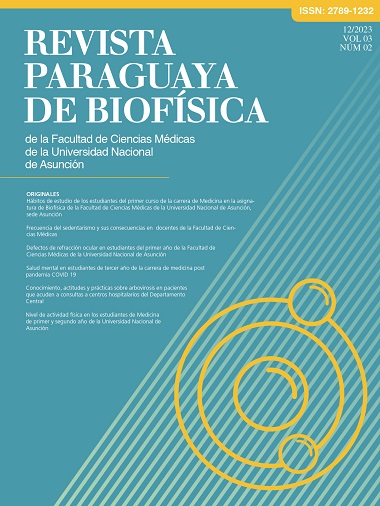Frecuencia del sedentarismo y sus consecuencias en docentes de la Facultad de Ciencias Médicas
Palabras clave:
Sedentarismo, dolor muscular, dolor articular, frecuencia de actividades físicas, docentes, saludResumen
Introducción: El sedentarismo es un estilo de vida que se caracteriza por la inactividad física o la falta de ejercicio. Cuando una persona pasa la mayor parte del día sentada sin realizar actividad física, es considerada sedentaria. Según la Organización Mundial de la Salud (OMS), la inactividad es uno de los problemas más importantes de la salud pública ya que afecta a millones de personas en todo el mundo y se estima que un 60% de la población mundial no realiza la actividad física necesaria para obtener beneficios para la salud.
Objetivos: El objetivo general de este trabajo de investigación fue analizar la frecuencia del sedentarismo en docentes de la Facultad de Ciencias Médicas de la Universidad Nacional de Asunción.
Se determinó los factores sociodemográficos tales como sexo, rango de edad y el estado civil de los encuestados, así también se identificó el porcentaje de docentes que realizan actividad física y la frecuencia de actividad física en el caso de que la realice, también se evaluó la presencia de dolor muscular, articular o ambos experimentado por los docentes, la frecuencia del dolor ya sea muscular o articular en caso de presentar dicho dolor y se estimó la severidad del dolor mediante la Escala Visual Analógica del dolor (EVA), además se identificó las zonas más afectadas al presentar dolor articular y/o muscular y por último también se reveló las cantidad de horas diarias trabajadas por los docentes de la Facultad de Ciencias Médicas la Universidad Nacional de Asunción.
Materiales: El estudio fue observacional, descriptivo y transversal basado en los resultados de una encuesta hecha por Google Forms a 51 docentes de la Facultad de Ciencias Médicas de la Universidad Nacional de Asunción.
Resultados: La mayor parte de los encuestados fueron del sexo femenino, el rango de edad se encuentra entre los 36 a 45 años de edad y en su mayoría son solteros, cabe destacar que el 68,6% de docentes realiza actividad física. La frecuencia de actividad física realizada por los docentes es de 1 a 2 veces por semana, con respecto a la presencia de dolor el 41,2 remitieron no sentir ningún dolor, pero un 23,7% siente dolor muscular y un 21,6% siente dolor muscular y articular. Los docentes que presentan dolor muscular experimentan dicho dolor 1 a 2 veces al mes según el porcentaje más alto (46,4%) pero un 10,7% de docentes experimentan dolor muscular todos los días con un rango de severidad de dolor de 1 a 7 grados y la zona más afectada es la región de la espalda y los docentes qué presentan dolor articular experimentan dicho dolor también 1 a 2 veces al mes con un porcentaje de 50% pero así también un 20,8% experimenta dolor articular todos los días con un rango de severidad de 1 a 8 grados de dolor, siendo la zona más afectado con dolor articular la región de las rodillas y por último la mayoría de docentes trabajan más de 6 horas diarias.
Conclusiones: Mediante el estudio se obtuvo información sociodemográfica (sexo, edad, estado civil) sobre la población de docentes de la Facultad de Ciencias Médicas donde predominó el sexo femenino, la edad mayoritaria de los docentes se encuentra entre los 36 a 45 años de edad y la mayoria son solteros. Se evaluó la presencia y se estimó frecuencia de actividad física donde un 30% de docentes encuestados no realiza ninguna actividad física y los qué realizan actividad física tienen una frecuencia de 1 a 2 veces al mes. Se estableció la presencia de dolor muscular en un 23,5% y la presencia de dolor articular en un 13,7% y así también hay un 21,6% de docentes que presenta ambos dolores, se pudo describir la frecuencia de dolor tanto muscular y articular donde los docentes presentan dolor muscular y/o articular 1 a 2 veces al mes también se pudo estimar el grado de severidad de dolor muscular con un grado de dolor de 1 a 7 y el grado de dolor articular en 1 a 8. También se pudo revelar la cantidad de horas diarias qué trabajan los encuestados y está superan las 6 horas diarias de trabajo en un 88,2%.
Descargas
Citas
(1) Cristi-Montero C, Celis-Morales C, Ramírez-Campillo R, Aguilar-Farías N, Álvarez C, Rodríguez-Rodríguez F. ¡Sedentarismo e inactividad física no son lo mismo!: una actualización de conceptos orientada a la prescripción del ejercicio físico para la salud. Rev Med Chil [Internet]. 2015 [citado el 22 de noviembre de 2023];143(8):1089–90. Disponible en: http://www.scielo.cl/scielo.php?script=sci_arttext&pid=S0034-98872015000800021
(2) Méndez Urresta EM, Méndez Urresta JB, Méndez Carvajal EP, Ortiz Arciniega JL, Méndez Carvajal VC. Práctica de actividad física: barreras para el ejercicio en docentes universitarios en época de pandemia/confinamiento. Universidad y Sociedad [Internet]. 2022 [citado el 22 de noviembre de 2023];14(3):724–32. Disponible en: http://scielo.sld.cu/scielo.php?script=sci_arttext&pid=S2218-36202022000300724&lng=es&tlng=es
(3) Bazán N, Echandía N, Gatica M, Laiño F, Valenti C. Niveles de actividad física y sedentarismo en personal de la salud. Rev Fac Cs Méd UNR [Internet]. 2021 [citado el 22 de noviembre de 2023];1:122–9. Disponible en: https://fcmcientifica.unr.edu.ar/index.php/revista/article/view/28
(4) Plasencia A, Almendra G. Obesidad, sedentarismo y síndrome de burnout en trabajadores. Revisión sistemática. Universidad César Vallejo; 2021. Disponible en: https://repositorio.ucv.edu.pe/handle/20.500.12692/83557
(5) Winder DAC, Bravo GB, Cucci SB. Asociación entre el nivel de actividad física, sedentarismo y dolor de espalda en estudiantes de nutrición y dietética de una universidad de Lima en contexto de Pandemia por COVID-19. Retos Digit [Internet]. 2022 [citado el 22 de noviembre de 2023];(45):1019–30. Disponible en: https://dialnet.unirioja.es/servlet/articulo?codigo=8451495
(6) Gutierrez-Calderón MA, Diaz-Therán KM. Factores de riesgo psicosocial intralaborales y su relación con dolor músculo esquelético en docentes universitarios. Univ Salud [Internet]. 2021 [citado el 22 de noviembre de 2023];23(3):329–36. Disponible en: https://revistas.udenar.edu.co/index.php/usalud/article/view/6397
(7) El 75% de los paraguayos corre el riesgo de enfermarse debido al sedentarismo [Internet]. Gov.py. [citado el 22 de noviembre de 2023]. Disponible en: https://portal.mspbs.gov.py/el-75-de-los-paraguayos-corre-el-riesgo-de-enfermarse-debido-al-sedentarismo/
(8) Color ABC. Paraguayos sedentarios [Internet]. ABC Color. 2013 [citado el 22 de noviembre de 2023]. Disponible en: https://www.abc.com.py/nacionales/paraguayos-sedentarios-582158.html
(9) Riesgos de una vida sedentaria. Fitness and Exercise [Internet]. 2017 [citado el 22 de noviembre de 2023]; Disponible en: https://medlineplus.gov/spanish/healthrisksofaninactivelifestyle.html
(10) Domínguez Gabriel CM, Pacheco Preciado AR, Franco Escobar C, Petro JL, Calvo Betancur VD. Actividad física, composición corporal, fuerza prensil y consumo de alimentos en trabajadores de una institución de educación superior. Rev Fac Nac Salud Pública [Internet]. 2021 [citado el 22 de noviembre de 2023];39(2):1–13. Disponible en: https://revistas.udea.edu.co/index.php/fnsp/article/view/342389
(11) Pardo G, María L. Conductas sedentarias y síndrome de Burnout en docentes. Bogotá, Colombia. 2018 [citado el 22 de noviembre de 2023]; Disponible en: https://repository.urosario.edu.co/handle/10336/19011
(12) El sedentarismo y el nivel de actividad física en docentes de dos centros educativos de Quito-Ecuador [Internet]. Retosdelacienciaec.com. [citado el 22 de noviembre de 2023]. Disponible en: https://retosdelacienciaec.com/Revistas/index.php/retos/article/view/294/198
(13) Medina Paredes SV, Flores Robalino RG, Villalba Garzón GA, Barrera Cueva J del C. Identificación de problemas de salud como efecto del sedentarismo: Un estudio con personas dedicadas a la docencia durante la pandemia covid19. Conciencia Digital [Internet]. 2021 [citado el 22 de noviembre de 2023];4(1.2):457–69. Disponible en: https://cienciadigital.org/revistacienciadigital2/index.php/ConcienciaDigital/article/view/1612
(14) García-Salirrosas EE, Sánchez-Poma RA. Prevalencia de trastornos musculoesqueléticos en docentes universitarios que realizan teletrabajo en tiempos de COVID-19. An Fac Med (Lima Peru : 1990) [Internet]. 2020 [citado el 22 de noviembre de 2023];81(3). Disponible en: https://revistasinvestigacion.unmsm.edu.pe/index.php/anales/article/view/18841
(15) Mendoza Fritz ME, Lora Flórez B, Pérez Martínez J. Caracterización de la sintomatología osteomuscular en docentes de la institución Educativa Despertar del sur en la ciudad de Barranquilla agosto 2016 a junio 2017. 2017. Disponible en: https://repository.unilibre.edu.co/handle/10901/23428
(16) Muñoz Rodríguez DI, Gallego Ortega LI. Sedentarismo en un grupo de docentes de un programa de salud de Medellín, 2021. Revista CES Salud Pública y Epidemiología [Internet]. 2023 [citado el 22 de noviembre de 2023];1(2):51–71. Disponible en: https://revistas.ces.edu.co/index.php/spe/article/view/7097
Descargas
Publicado
Cómo citar
Número
Sección
Licencia
Derechos de autor 2024 Sofía Magali Godoy Cabral, María Belén Gómez Giménez, Karen Arami González Delvalle, María del Mar González Domínguez, Milagros González Guasch, Noelia Beatriz González Lugo, Tobías Adrián González Ruiz Díaz, Nailea Irasema Granado Benítez, Shin Han Kim, Idalina Stanley, Lourdes Carolina Vázquez Jiménez

Esta obra está bajo una licencia internacional Creative Commons Atribución 4.0.





